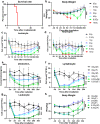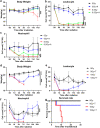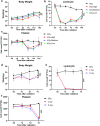Serum sSelectin-L is an early specific indicator of radiation injury
- PMID: 38778981
- PMCID: PMC11109730
- DOI: 10.1016/j.heliyon.2024.e30527
Serum sSelectin-L is an early specific indicator of radiation injury
Abstract
Objective: It's crucial to identify an easily detectable biomarker that is specific to radiation injury in order to effectively classify injured individuals in the early stage in large-scale nuclear accidents.
Methods: C57BL/6J mice were subjected to whole-body and partial-body γ irradiation, as well as whole-body X-ray irradiation to explore the response of serum sSelectin-L to radiation injury. Then, it was compared with its response to lipopolysaccharide-induced acute infection and doxorubicin-induced DNA damage to study the specificity of sSelectin-L response to radiation. Furthermore, it was further evaluated in serum samples from nasopharyngeal carcinoma patients before and after radiotherapy. Simulated rescue experiments using Amifostine or bone marrow transplantation were conducted in mice with acute radiation syndrome to determine the potential for establishing sSelectin-L as a prognostic marker. The levels of sSelectin-L were dynamically measured using the ELISA method.
Results: Selectin-L is mainly expressed in hematopoietic tissues and lymphatic tissues. Mouse sSelectin-L showed a dose-dependent decrease from 1 day after irradiation and exhibited a positive correlation with lymphocyte counts. Furthermore, the level of sSelectin-L reflected the degree of radiation injury in partial-body irradiation mice and in nasopharyngeal carcinoma patients. sSelectin-L was closely related to the total dose of γ or X ray. There was no significant change in the sSelectin-L levels in mice intraperitoneal injected with lipopolysaccharide or doxorubicin. The sSelectin-L was decreased slower and recovered faster than lymphocyte count in acute radiation syndrome mice treated with Amifostine or bone marrow transplantation.
Conclusions: Our study shows that sSelectin-L has the potential to be an early biomarker to classify injured individuals after radiation accidents, and to be a prognostic indicator of successful rescue of radiation victims.
Keywords: Acute radiation syndrome; Biomarker; Irradiation; sSelectin-L.
© 2024 The Authors.
Conflict of interest statement
The authors declare that they have no known competing financial interests or personal relationships that could have appeared to influence the work reported in this paper.
Figures













Similar articles
-
Haptoglobin is an early indicator of survival after radiation-induced severe injury and bone marrow transplantation in mice.Stem Cell Res Ther. 2022 Sep 6;13(1):461. doi: 10.1186/s13287-022-03162-x. Stem Cell Res Ther. 2022. PMID: 36068556 Free PMC article.
-
Serum amyloid A1 as a biomarker for radiation dose estimation and lethality prediction in irradiated mouse.Ann Transl Med. 2019 Dec;7(23):715. doi: 10.21037/atm.2019.12.27. Ann Transl Med. 2019. PMID: 32042731 Free PMC article.
-
[Effect of Interleukin-6 Gene Deletion on Radiation-Induced Mouse Hematopoietic Injury and Relative Mechanism].Zhongguo Shi Yan Xue Ye Xue Za Zhi. 2022 Aug;30(4):1255-1261. doi: 10.19746/j.cnki.issn.1009-2137.2022.04.045. Zhongguo Shi Yan Xue Ye Xue Za Zhi. 2022. PMID: 35981394 Chinese.
-
Single-Dose Administration of Recombinant Human Thrombopoietin Mitigates Total Body Irradiation-Induced Hematopoietic System Injury in Mice and Nonhuman Primates.Int J Radiat Oncol Biol Phys. 2020 Dec 1;108(5):1357-1367. doi: 10.1016/j.ijrobp.2020.07.2325. Epub 2020 Aug 3. Int J Radiat Oncol Biol Phys. 2020. PMID: 32758640
-
Acute Radiation-induced Lung Injury in the Non-human Primate: A Review and Comparison of Mortality and Co-morbidities Using Models of Partial-body Irradiation with Marginal Bone Marrow Sparing and Whole Thorax Lung Irradiation.Health Phys. 2020 Nov;119(5):559-587. doi: 10.1097/HP.0000000000001346. Health Phys. 2020. PMID: 33009295 Free PMC article. Review.
Cited by
-
Single-Cell Sequencing: An Emerging Tool for Biomarker Development in Nuclear Emergencies and Radiation Oncology.Cancers (Basel). 2025 May 28;17(11):1801. doi: 10.3390/cancers17111801. Cancers (Basel). 2025. PMID: 40507282 Free PMC article. Review.
References
-
- Wong K., Siu L., Ainsbury E., Moquet J. Cytogenetic biodosimetry: what it is and how we do it. Hong Kong Med. J. 2013;19(2):168–173. - PubMed
LinkOut - more resources
Full Text Sources

